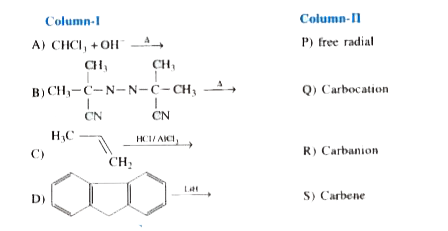Ambiphiles are those species which behave like electrophiles and nucleophiles. Eg H−..O..−H,R−..O..−H etcSolution in Telugu
Step by step video & image solution for Ambiphiles are those species which behave like electrophiles and nucleophiles. Eg H- underset(..)overset(..)(O)- H, R - underset(..)overset(..)(O)-H etc by Chemistry experts to help you in doubts & scoring excellent marks in Class 11 exams.
Updated on:21/07/2023Topper's Solved these Questions
- GENERAL ORGANIC CHEMISTRYBOOK - AAKASH SERIESCHAPTER - GENERAL ORGANIC CHEMISTRYEXERCISE - Objective Exercise -1
204 Videos
- GENERAL ORGANIC CHEMISTRYBOOK - AAKASH SERIESCHAPTER - GENERAL ORGANIC CHEMISTRYEXERCISE - Objective Exercise -2
82 Videos
- GENERAL ORGANIC CHEMISTRYBOOK - AAKASH SERIESCHAPTER - GENERAL ORGANIC CHEMISTRYEXERCISE - Subjective Exercise -7
8 Videos
- ENVIRONMENTAL CHEMISTRYBOOK - AAKASH SERIESCHAPTER - ENVIRONMENTAL CHEMISTRYEXERCISE - EXERCISE ON PASSAGE (PASSAGE-III)
5 Videos
- HYDROCARBONSBOOK - AAKASH SERIESCHAPTER - HYDROCARBONSEXERCISE - ADDITIONAL PRACTICE SHEET ( LEVEL-II (PRACTICE SHEET (ADVANCED) (MATRIX MATCHING TYPE QUESTIONS)))
5 Videos
Similar Questions
Urea was prepared first time in the laboratory by heating
View SolutionThe compound containing sp sp2 and sp3 hybridised carbon atoms in 1:2:3 ratio is
View SolutionExplain (a) column chromatography, (b) thin layer chromatography and (c ) partition chromatography
View SolutionOzone layer acts as one of the most important life support system. The major cause of ozone layer destruction is believed to be the release of chlorofluorocarbon compounds. UV radiation causes the chlorofluouocarbons to dissociate : CF2Clhv−−→Cl⋅+CF2CI A highly reactive chlorine atomis responsible for the decomposition of ozone. Cl⋅+O3(g)→ClO⋅+O2(g)ClO⋅+O(g)→Cl⋅+O2(g) Free radicals of chlorine decompose ozone molecules in a chain reaction. The depletion of ozone layer leading to ozone hole has, however, been mainly observed in the stratosphere over Antarctica. Special type of cloud called polar stratospheric colouds are formed over Antarctica.These clouds (contain solid HNO3.3H2O) play an important role in ozone depletion.
ClO⋅+NO2→ClONO2
ClONO2+H2O→HOCl+HNO3
ClONO2+HCl→Cl2+HNO3
HOClhv−−→HO⋅+Cl⋅
The reactive chlorine atoms thus formed are rendered to deplete ozone layer.
The ozone layer is present in :
View SolutionMatch the intermediates formed in the reaction.

View SolutionIdentify and name the functional groups present in the following compounds. (a) H-underset(H)underset(|)overset(H)overset(|)C-underset(H)underset(|)overset(H)overset(|)C-underset(H)underset(|)overset(H)overset(|)C-OH , (b) H-underset(H)underset(|)overset(H)overset(|)C-underset(H)underset(|)overset(H)overset(|)C-overset(O)overset(||)C-OH (c ) H-underset(H)underset(|)overset(H)overset(|)C-underset(H)underset(|)overset(H)overset(|)C-overset(O)overset(||)C-underset(H)underset(|)overset(H)overset(|)C-underset(H)underset(|)overset(H)overset(|)C-H , (d) H-underset(H)underset(|)overset(H)overset(|)C-underset(H)underset(|)overset(H)overset(|)C-overset(H)overset(|)C=overset(H)overset(|)C-H
View Solutionदिए गए यौगिक का IUPAC नामकरण कीजिए-
H−H∣C∣H−H∣C∣H−H∣O∣C∣H−H∣C∣H−H
View Solutionकिस एस्टर का संरचनात्मक सूत्र है-
H−H।H।H−C।।O−O−H।C।H−H।C।H−H
उस अम्ल तथा ऐल्कोहॉल का सूत्र लिखिए, जिसमे इसको बनाया गया है।
View Solutionनिम्नलिखित यौगिकों के आई०यू०पी०ए०सी० नाम लिखिए।
H−H|C|H−H|C|H−C|O|H=O
View SolutionH−H∣C∣H−O∣∣C−O−H∣C∣H−H is a/ an _____.
View SolutionWrite the IUPAC names of the following compounds : H-overset(H)overset(|)underset(H)underset(|)C-overset(H)overset(|)underset(H)underset(|)C-overset(H)overset(|)underset(H)underset(|)C-overset(H)overset(|)underset(H)underset(|)C-overset(O)overset(||)C-O-H
View SolutionWrite the IUPAC names of the following compounds :
H−H∣C∣H−H∣C∣H−H∣C∣H−H∣C∣H−O∣∣C−O−H
View Solutionदिए गए यौगिक का IUPAC नामकरण कीजिए-
H−H∣C∣H−H∣C∣H−H∣O∣C∣H−H∣C∣H−H
View SolutionName the following compound :
(i)H−H∣C∣H−O∣∣C−H∣C∣H−H (ii)H−H∣C∣H−H∣C∣H−H∣C∣H−H∣C=O
(iii)H−O∣∣C−OH
View SolutionIdentify and name the functional groups present in the following compounds.
(a) H−H∣C∣H−H∣C∣H−H∣C∣H−OH , (b) H−H∣C∣H−H∣C∣H−O∣∣C−OH
(c ) H−H∣C∣H−H∣C∣H−O∣∣C−H∣C∣H−H∣C∣H−H , (d) H−H∣C∣H−H∣C∣H−H∣C=H∣C−H
View Solution
